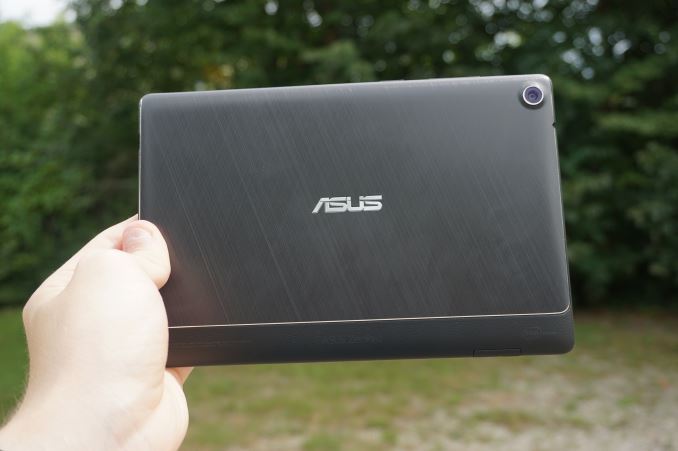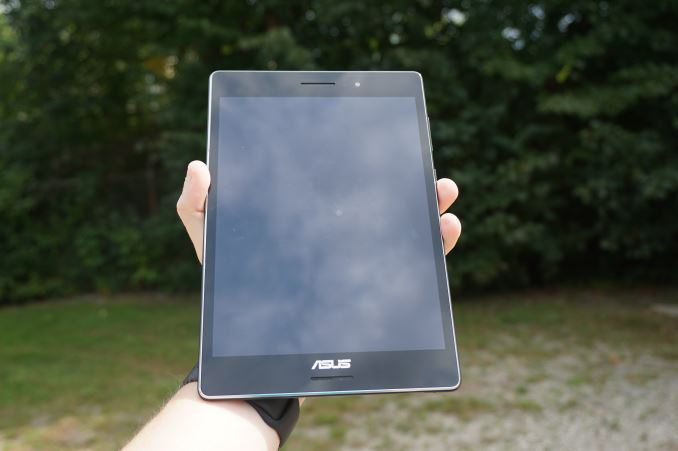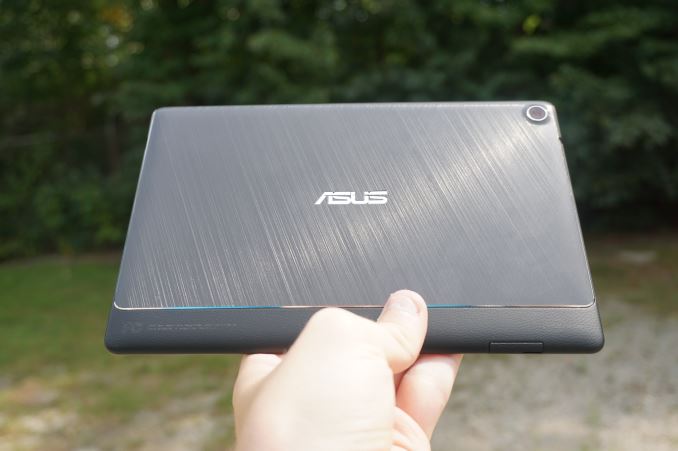The ASUS ZenPad S (Z580CA) Review
by Brandon Chester on August 31, 2015 8:00 AM ESTFinal Words
As I said in the introduction, its been a long time since we've seen a tablet from ASUS that wasn't aimed at the low end of the market. The ZenPad S Z580CA isn't a $500 flagship tablet, but with the specifications it provides it's essentially a high end 8" Android tablet. Like the ZenFone 2, its $299 price would have you believe that its specifications are less impressive than they really are. However, it's really impossible to judge a device solely based on how it looks on paper, even when what you seen on a spec sheet looks appealing. Over the course of reviewing the ZenPad S I've encountered aspects of it that are good, and some that need improvement. I suppose this is the best time to go over everything once more before making some conclusions.
The ZenPad S does a good job of making a plastic chassis feel solid and high quality. The hard plastic on the back does a better job of emulating the feeling of metal than any other device I've used before. I personally would have not opted to make the sides and part of the back cover out of a soft touch plastic, because it introduces seams and breaks in the chassis which is detrimental to the design. I also feel a bit spoiled by the fact that there are devices like the iPad Mini 2 which give you a fully aluminum chassis for $299 as well. The ZenPad ends up being thinner and much lighter than the iPad, which is certainly a benefit for any user who wants a device that they can bring everywhere without feeling like they're lugging around a heavy object. My personal use case for a tablet leads me to lean toward a thicker and heavier aluminum chassis over a thinner and lighter plastic one, but I recognize that other people may have different needs which make the ZenPad S a more appealing device in that regard.
One area where an aluminum chassis would certainly help is durability. While metal can obviously dent and scratch, my time with the ZenPad S has made it clear that there are both issues with the durability of the plastic used, and with the tolerances for defects in the materials. If I was purchasing the ZenPad S for myself I would definitely not consider the deformed edges of the hard plastic that my review unit has to be acceptable, and the same would go for the easily damaged edge around the bezel. Even without a metal chassis, other plastic tablets like the Dell Venue 10 and the Nexus 9 have held up much better over the course of weeks and months than the ZenPad S did in only a week. Durability is definitely something to keep in mind if you're fairly rough on your devices, or if you want to keep your ZenPad for a long period of time.
As far as performance goes, the ZenPad S is right in line with all the other Intel devices that I've looked at. The 4GB of RAM means that you will rarely ever see a process be evicted from memory, but with Android having no support for split screen application views it almost feels like the ZenPad S has some untapped potential. The CPU performance is just as good if not better than anything else you'll find at this price, and the 533MHz G6430 GPU ends up being slightly faster than the implementation in Apple's A7 SoC. In my reviews of Dell's Venue tablets I remarked that Atom Z3580 didn't feel competitive enough in a $400 or $500 device, but in a $300 tablet it feels right at home.
The ZenPad's display is difficult to come to a conclusion on. Out of the box the image rendition is very inaccurate, but you can make significant improvements by adjusting the color temperature. My problem with this is that I think it's wrong to offer bad default settings that the user has to fix on their own, especially when there's no way they can find the optimal setting for a display by using their eye alone. Even after adjusting the display, the overall accuracy is still significantly lower than the iPad Mini 2 despite the ZenPad S not suffering from the narrow gamut that the iPad does.
On top of the issues with color accuracy, ASUS's True2Life+ tweaks have a very negative impact on display quality. The over-sharpening causes halos around text, and when text is a small size it actually makes it more difficult to read than it would be if it hadn't been artificially sharpened, which is contrary to the entire point of sharpening. ASUS's CABC also goes way overboard, to the point where you can notice the brightness of the display constantly shifting as you scroll around and move between apps. Without True2Life+ I would still lean toward the iPad Mini 2 having a better display due to its greater accuracy with common color mixtures, even if it does have a narrow gamut and isn't laminated. Despite that, I would have said that the ZenPad S's display is still very good for a $299 device. Unfortunately, the post processing that ASUS performs really degrades image quality to the point where the ZenPad's display is not something I can highly praise.
There's not much to say about the camera quality of the ZenPad S. It suffers from all the same issues as the ZenFone 2, and I really wouldn't use it to take photos unless there's no alternative. Thankfully I don't think that the camera is a huge selling point for a $300 tablet, and so this problem isn't that serious.
Battery life on the ZenPad S was good considering the battery capacity it's working with, but not competitive with other tablets. With tablets there's really no room to have your battery life fall short, because there's been an expectation of ten hours of battery life from tablets for over five years now. In every battery category the ZenPad either doesn't last as long as competing tablets, or lasts as long or longer but with the caveat that performance over that period of time wasn't as high as the competition. I think a larger battery would have really been beneficial, even if it meant that the ZenPad S Z580CA had to be heavier and 7mm or 7.5mm thick instead of 6.6mm.
In the end I'm not as impressed by the ZenPad S Z580CA as I was with the ZenFone 2. In the case of the ZenFone 2 I actually felt that the $199 model offered the best value because you were only trading away some NAND, dropping to 2GB of RAM, and limiting the CPU clock to 1.8GHz instead of 2.33GHz. If the ZenPad S Z580C was the same sort of downgrade I would have no trouble recommending it for $199. However, you end up with significant reductions to both the CPU and GPU clocks, worse cameras, halved RAM and NAND, no 802.11ac WiFi (assuming it gets fixed on the Z580CA), and no USB Type-C connector. That's a lot of sacrifices to save $100, and the performance impact of dropping the max CPU clock to 1.33GHz would be very significant in bursty workloads.
As for the Z580CA itself, there are just a lot of issues that are difficult to overlook. The build quality and construction is just not competitive with the iPad Mini 2 or the more expensive but still relevant Dell Venue 8 7840. Much of the other issues are rooted in software, like the WiFi issue, the display issues, the camera issues, and before a recent software update, the video playback issues. While I didn't talk about ZenUI in this review, anyone who visited the link to my discussion of it in my ZenFone 2 review knows that you'll also be dealing with a large number of pre-installed apps on the ZenPad S, with most of them not being very useful. There's also still the fact that the library of really good tablet apps for Android devices is still quite small, and while this isn't within ASUS's control, it's still a very real issue to consider when you have the iPad Mini 2 competing at the exact same price.
At $299, the ZenPad S Z580CA actually doesn't have much in the way of direct competition from other Android OEMs. The $399 price point seems to be where a lot of manufacturers have aimed, with devices like the Dell Venue 8, Nexus 9, and Galaxy Tab S2 8.0 all selling for that price. With that in mind, the ZenPad S does end up being the best device at its price point, but due to a lack of competition more than anything else. If I were recommending a tablet to someone aiming to spend around $299 I would still lean toward the iPad Mini 2 if they weren't partial to Android or iOS. If someone does really need a tablet that runs Android for any number of reasons then I think it would be best to save up and take a look at the devices selling for around $400. That being said, if a user can't use a tablet that runs iOS and can't budge from a $300 price, then the ZenPad S Z580CA appears to be the best of the few options available.













114 Comments
View All Comments
BugblatterIII - Monday, August 31, 2015 - link
I wasn't even talking about the GPS; way to jump to conclusions and run a mile with them!And I did get the dongle.
3DoubleD knows what he's talking about (oh and don't forget the interminable hangs on web browsing). MrSavage I suggest you read and learn.
My current router and motherboard are from Asus, no complaints. When it comes to tablets (and probably smartphones) I'd steer well clear. This review mentions some serious issues at launch; they shouldn't exist.
MrSavage - Monday, August 31, 2015 - link
If you recall, the Prime just came out, some hadn't even shipped, and Asus showed of the Transformer Infinity at CES to the dismay of many. The fact is this. That was a ground breaking product, in its second iteration. Nobody else was attempting what they did. Design wise a fail? Sure. But to me, I give full credit for a company that has the balls to release innovative and cutting edge products. They didn't repeat the mistake. Hold a grudge? LOL, go ahead. I'll always praise innovation even if it means problems. Apple antennagate? Happens to even the best companies out there.BugblatterIII - Tuesday, September 1, 2015 - link
The bits they failed on weren't the innovative bits. The keyboard worked very well for example. It was the actual tablet bit where they fell down. They shouldn't have shipped it in that state; they used seriously under-specced hardware and that's probably the real reason they were never able to fix it with firmware.A few years on perhaps they've learned, or perhaps the decision-makers have changed. However the fact they're launching with major issues suggests otherwise, and those who do not learn from history are doomed to take Summer School.
You call it holding a grudge; I call it learning from experience. Same reason I won't touch Belkin.
3DoubleD - Tuesday, September 1, 2015 - link
Agreed. The innovative bits were great. The keyboard with extra battery life - fantastic. Screen was beautiful, even if it was only 720p. Two SD card slots and a full sized USB port - great. ASUS' Android wasn't even too bad (pretty close to stock with some small, helpful additions). But screwing up one of the core components of the system was not a failed innovation, it was poor engineering and quality control. It was also a not a common failure that was unique to the Prime, despite all phones and tablets having eMMC devices. It was such a failure, crippling the usability to such an extent that a recall should have taken place. Hilariously, the previous Transformer tablet has aged far better, while having all of the innovative features, so again, I don't think ASUS should get a free pass because it was 'ballsy'.3DoubleD - Tuesday, September 1, 2015 - link
"It was also a not a common failure, *but* was unique to the Prime..."MrSavage - Monday, August 31, 2015 - link
I registered to ask this question. You guys are known for your "technical" analysis. The issue with reviews is with the basis of comparison or lack thereof. Instead of saying this is the best $299 8-inch Android tablet on the market, you can't and really don't. Instead, you suggest spending another 1/3 of the price for something else!? Or yet get an old, outdated iPad mini 2?What are front facing speakers worth to a tablet user? What is a stylus input worth to a tablet user?
It would seem that the reviewer doesn't know the Samsung Tab S2 8.0. Explain what that extra $100 in price gets you, that's better than the $100 cheaper Android tablet. The point is, expand on a spec basis what makes the extra $100 a better buying option. Perhaps your readers only shop for the most expensive product. In that case, each review will be price based. The most expensive on the market = the best. Thus, a review just explains why the premium cost is worthwhile. To write in the review that looking at the $100 more expensive Tab S2 is worth considering? How about why? Why is that worth it?
DanNeely - Monday, August 31, 2015 - link
*sigh* Up until I saw the display and battery sections I was somewhat interested in this tablet.Is there anyone selling an 8" android tablet that isn't either a cheap wretched piece of crap or fundamentally broken in some way (eg Samsung's backwards buttons, Kindle's lack of Google apps, etc)?
MrSavage - Monday, August 31, 2015 - link
Unrealistic consumer? Wants - long battery life, best display on market. Wants - cheapest price possible. Seriously? If battery life is crucial, there are things called external battery packs. $20 perhaps? Not tied into a device and can be used for other devices. Display issues? Check the specs on the new Tab S2 8.0 and then look at the price. I think I go back to the first two words I wrote in this comment. Something to think about.DanNeely - Monday, August 31, 2015 - link
How exactly do you go from my not wanting a cheap piece of crap to my wanting something as cheap as possible? For that matter I just cited Samsung's tablets as an example of a device with a fundamentally broken mis-feature.I want a good tablet without anything stupidly wrong on it. I'd gladly pay $400 for something like the Tab S2 8 if Samsung didn't insist on ruining all of their Android devices by screwing the buttons up.
As it is, the Android tablet market has gotten worse than the PC laptop market. The latter at least has enough options that, even though virtually every product has at least one item where they either cheaped out one component to something awful to save a dollar on the BOM or made an generally idiotic design option, I can at least find something that doesn't have a flaw that's a show stopper for me. (XPS 13 laptop, the black tape lens cap on the neckbeard/nose hair camera is less noticeable than the tape over a more conventionally placed camera.) I've been on/off looking for an android tablet all summer; but every time I see something to catch my eye midway through the review there's something that triggers an immediate "OH HELL NO!!!" response.
MrSavage - Monday, August 31, 2015 - link
You are simply being unrealistic, that's my point. Android isn't Apple. Go ahead and go spec by spec through the Z580CA and Tab S2 8.0 comparison and then add the extra $100 you would be spending on that new Samsung.If you think for a moment that the Z580CA is a cheap piece of crap, then no doubt why you are without an Android tablet. You are taking this review as the final word.
Battery life can be solved pretty darn easily, unless their is some issue with portable charger and Type-C.
I am curious though, what's the "hell no" aspect of the Z580CA? I hope it's not the wifi which has been reviewed on a firmware that needs updating/tweaking.
Display wise? I think the reviewer has a built in bias against display enhancements. Lots of charts and graphs talking about display. However, do you really think any of those graphs and charts mean anything to the real world, end user? If you are an elite user, then go ahead and look outside of Android and pay double or triple the price for an Apple display.
I hear what you want. You want an Apple quality device with Android OS. I think the manufacturers have tried and failed at that game and it's why price is their primary goal. Perhaps you can hope for a ZenPad Pro or something similar.
Personally? I would rather have a thicker, heavier and even slightly higher priced Z580CA if it meant bigger battery. However, I can easily get around battery life issues. No ideal, but possible.
Front facing speakers are of no value to you? Stylus input is of no value to you?
The bad thing about charts is that a device which is priced 20% to 40% cheaper will be compared against the most premium expensive models on the market. Is it logical to have them all bunched together? Do car review put Ferrari's against Honda in their speed or performance comparison tests? Some comparisons are illogical.